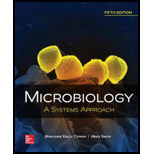
Concept explainers
Introduction:
The cardiovascular system is also known as the circulatory system is a system which allows blood to flow throughout the body and transports nutrients, gases and other important enzymes in and out of the cells. It is composed of two components: Heart and the blood vessels.
Answer to Problem 1MCQ
Correct answer:
The condition in which bacteria grow and flourish in the bloodstream is referred to as septicemia. Therefore, option (c) is correct.
Option (c) is given as “septicemia”.
Explanation of Solution
Justify the reason for the correct statement:
Sepsis is also known as septicemia is a cardiovascular condition caused by many bacteria and few
Hence, option (c) is correct.
Justify the reasons for the incorrect statements:
Option (a) is given as “viremia”.
It is the presence of virus in the blood. Hence, it is a wrong answer.
Option (b) is given as “bacteremia”.
It referrers to the appearance of bacteria in the blood which does not correspond to their growth. Hence, it is a wrong answer.
Option (d) is given as “fungemia”.
It is the presence of only fungi in the blood. Hence, it is a wrong answer.
Hence, options (a), (b), and (d) are incorrect.
When bacteria grow and flourish in the bloodstream then this condition is referred to as septicemia.
Want to see more full solutions like this?
Chapter 20 Solutions
Microbiology: A Systems Approach
- Which of the following is an air-borne disease? A. Measles B. Typhoid C. Pink eye D. None of the abovearrow_forwardThe genera that may cause Pneumococcal Disease Select one: a. Staphylococcus and Streptococcus O b. Bacillus and Salmonella c. Listeria and Escherichia d. Clostridium and Bacillusarrow_forwardWhich organism is the most common cause of hematogenous osteomyelitis in sickle cell patients?a. Haemophilus influenzab. Staphylococcus aureusc. Group B streptococcid. Salmonellae. Bacillus anthracisarrow_forward
- Which of the following is not an acid fast bacterium: A. Mycobacterium tuberculosis B. Salmonella enterica C. Mycobacterium leprae D. Nocardia asteroidesarrow_forwardwhich of the following antibiotics is not bactericidal? a. vancomycin b.polymyxin b c. penicillin d. cephalosporins e. tetracyclinearrow_forwardSoil mycobacteria can be the cause ofa. tuberculosis b. leprosy c. fish tank granuloma d. erysipeloidarrow_forward
- Blood in the stool may occur in which of the following? a. Salmonella infection b. rotavirus infection c. Clostridium difficile infection d. Shigella infection e. b, c, and d f. a, c, and darrow_forwardExplain the actions of each of the following that make them virulencefactors:a. hemolysins b. leukocidin c. kinases d. hyaluronidase e. coagulasearrow_forwardWhich of the following cause human food-borne illness: a. Lactobacillus acidophilus b. adding vinegar (acetic acid) to milk c. the botulinum toxin (Bo-tox) made by Clostridia botulinum d. Listeria monocytogenes e. Salmonella entericaarrow_forward
- 50. The patient above presents with severely flexed muscles, causing difficulty breathing and extreme discomfort. A stain performed on microbes isolated from a wound reveals the image above (right). What is the most likely diagnosis? A. Staph toxin B. botulism C. tetanus D. diphtheria E. endotoxemiaarrow_forwardThe disease from the list below which has a bacterial etiology is: A. Strep throat B. Asthma C. influenzaarrow_forwardWhich of the following is a true statement about food-borne infections? a. Hepatits B is frequently food-borne. b. E. coli outbreaks are nearly always caused by tainted ground beef. c. All E. coli are pathogenic. d. Shellfish can be contaminated with Vibrio cholera from their water source.arrow_forward
 Comprehensive Medical Assisting: Administrative a...NursingISBN:9781305964792Author:Wilburta Q. Lindh, Carol D. Tamparo, Barbara M. Dahl, Julie Morris, Cindy CorreaPublisher:Cengage Learning
Comprehensive Medical Assisting: Administrative a...NursingISBN:9781305964792Author:Wilburta Q. Lindh, Carol D. Tamparo, Barbara M. Dahl, Julie Morris, Cindy CorreaPublisher:Cengage Learning
